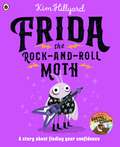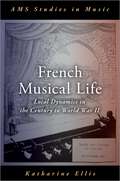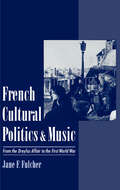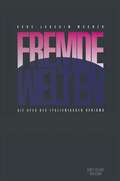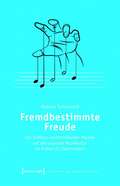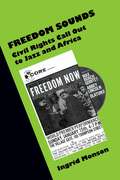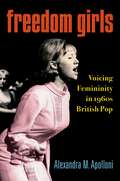- Table View
- List View
Fried & Justified: Hits, Myths, Break-Ups and Breakdowns in the Record Business 1978-98
by Mick HoughtonA Book of the Year, Uncut'A wild rock 'n' roll fairground ride of the damned.' Observer***We arrived in a fleet of white stretch limos at a clearing in a wood near Woking. Here the K Foundation was exhibiting a million pounds in cash, while Bill Drummond and Jimmy Cauty circled the perimeter in two orange Saracen armoured vehicles, blasting out Abba's 'Money Money Money' . . . Mick Houghton worked with some of the greatest, most influential and downright dysfunctional cult groups of the post-punk era and beyond - Ramones, Talking Heads, The Jesus and Mary Chain, The Undertones, Felt and Sonic Youth among them.But the three acts Mick is most closely identified with are Echo & the Bunnymen, Julian Cope, and the KLF. As confidant and co-conspirator, he navigated the minefield of rivalries and contrasting fortunes which make Fried & Justified such a candid, amusing and insightful picture of an exciting and inspirational period for music.
Frida the Rock-and-Roll Moth: A story about finding your confidence
by Kim HillyardA NEW picture book from the winner of the Best Illustrated Book, Waterstones Children's Prize 2023.Frida is a musical moth who loves to rock out - she puts on her pointy boots and plays her purple guitar really LOUD! But when the Big Bright Light is switched on, more moths appear, ready to rock together, and Frida starts to feel that everyone is much better than her. Perhaps she isn't so rock-and-roll after all . . .With the help of her biggest fan, Auntie Edna, Frida learns to reclaim her style, find her confidence and get up and rock on once more!This positive picture book will inspire readers to find what makes them feel good and let their inner confidence shine.Kim Hillyard creates positive, heart-warming stories that are designed to empower and inspire young readers. Each picture book focuses on a different feeling or belief to help children navigate the world around them.Also available from Kim Hillyard:Mabel and the Mountain: a story about believing in yourselfNed and the Great Garden Hamster Race: a story about kindnessGretel The Wonder Mammoth: a story about overcoming anxietyFlora and Nora Hunt for Treasure: a story about the power of friendship
French Musical Life: Local Dynamics in the Century to World War II (AMS Studies in Music)
by Katharine EllisExplicitly or not, the historical musicology of post-Revolutionary France has focused on Paris as a proxy for the rest of the country. This distorting lens is the legacy of political and cultural struggle during the long nineteenth century, indicating a French Revolution unresolved both then and now. In light of the capital's power as the seat of a centralizing French state (which provincials found 'colonizing') and as a cosmopolitan musical crossroads of nineteenth-century Europe, the struggles inherent in creating sustainable musical cultures outside Paris, and in composing local and regionalist music, are ripe for analysis. Replacement of 'France' with Paris has encouraged normative history-writing articulated by the capital's opera and concert life. Regional practices have been ignored, disparaged or treated piecemeal. This book is a study of French musical centralization and its discontents during the period leading up to and beyond the "provincial awakening" of the Belle ?poque. The book explains how different kinds of artistic decentralization and regionalism were hard won (or not) across a politically turbulent century from the 1830s to World War II. In doing so it redraws the historical map of musical power relations in mainland France. Based on work in over 70 archives, chapters on conservatoires, concert life, stage music, folk music and composition reveal how tensions of State and locality played out differently depending on the structures and funding mechanisms in place, the musical priorities of different communities, and the presence or absence of galvanizing musicians. Progressively, the book shifts from musical contexts to musical content, exploring the pressure point of folk music and its translation into "local color" for officials who perpetually feared national division. Control over composition on the one hand, and the emotional intensity of folk-based musical experience on the other, emerges as a matter of consistent official praxis. In terms of "French music" and its compositional styles, what results is a surprising new historiography of French neoclassicism, bound into and growing out of a study of diversity and its limits in daily musical life.
French Musical Life: Local Dynamics in the Century to World War II (AMS Studies in Music)
by Katharine EllisExplicitly or not, the historical musicology of post-Revolutionary France has focused on Paris as a proxy for the rest of the country. This distorting lens is the legacy of political and cultural struggle during the long nineteenth century, indicating a French Revolution unresolved both then and now. In light of the capital's power as the seat of a centralizing French state (which provincials found 'colonizing') and as a cosmopolitan musical crossroads of nineteenth-century Europe, the struggles inherent in creating sustainable musical cultures outside Paris, and in composing local and regionalist music, are ripe for analysis. Replacement of 'France' with Paris has encouraged normative history-writing articulated by the capital's opera and concert life. Regional practices have been ignored, disparaged or treated piecemeal. This book is a study of French musical centralization and its discontents during the period leading up to and beyond the "provincial awakening" of the Belle ?poque. The book explains how different kinds of artistic decentralization and regionalism were hard won (or not) across a politically turbulent century from the 1830s to World War II. In doing so it redraws the historical map of musical power relations in mainland France. Based on work in over 70 archives, chapters on conservatoires, concert life, stage music, folk music and composition reveal how tensions of State and locality played out differently depending on the structures and funding mechanisms in place, the musical priorities of different communities, and the presence or absence of galvanizing musicians. Progressively, the book shifts from musical contexts to musical content, exploring the pressure point of folk music and its translation into "local color" for officials who perpetually feared national division. Control over composition on the one hand, and the emotional intensity of folk-based musical experience on the other, emerges as a matter of consistent official praxis. In terms of "French music" and its compositional styles, what results is a surprising new historiography of French neoclassicism, bound into and growing out of a study of diversity and its limits in daily musical life.
French Musical Culture and the Coming of Sound Cinema (Oxford Music/Media Series)
by Hannah LewisThe transition from silent to synchronized sound film was one of the most dramatic transformations in cinema's history, as it radically changed the technology, practices, and aesthetics of filmmaking within a few short years. In France, debates about sound cinema were fierce and widespread. In French Musical Culture and the Coming of Sound Cinema, author Hannah Lewis argues that the debates about sound film resonated deeply within French musical culture of the early 1930s, and conversely, that discourses surrounding a range of French musical styles and genres shaped audiovisual cinematic experiments during the transition to sound. Lewis' book focuses on many of the most prominent directors and screenwriters of the period, from Luis Buñuel to Jean Vigo, as well as experiments found in lesser-known films. Additionally, Lewis examines how early sound film portrayed the diverse soundscape of early 1930s France, as filmmakers drew from the music hall, popular chanson, modernist composition, opera and operetta, and explored the importance of musical machines to depict and to shape French audiovisual culture. In this light, the author discusses the contributions of well-known composers for film alongside more popular music hall styles, all of which had a voice within the heterogeneous soundtrack of French sound cinema. By delving into this fascinating developmental period of French cinematic history, Lewis encourages readers to challenge commonly-held assumptions about how genres, media, and artistic forms relate to one another, and how these relationships are renegotiated during moments of technological change.
FRENCH MUS CULT & COM SOUND CIN OMMS C (Oxford Music/Media Series)
by Hannah LewisThe transition from silent to synchronized sound film was one of the most dramatic transformations in cinema's history, as it radically changed the technology, practices, and aesthetics of filmmaking within a few short years. In France, debates about sound cinema were fierce and widespread. In French Musical Culture and the Coming of Sound Cinema, author Hannah Lewis argues that the debates about sound film resonated deeply within French musical culture of the early 1930s, and conversely, that discourses surrounding a range of French musical styles and genres shaped audiovisual cinematic experiments during the transition to sound. Lewis' book focuses on many of the most prominent directors and screenwriters of the period, from Luis Buñuel to Jean Vigo, as well as experiments found in lesser-known films. Additionally, Lewis examines how early sound film portrayed the diverse soundscape of early 1930s France, as filmmakers drew from the music hall, popular chanson, modernist composition, opera and operetta, and explored the importance of musical machines to depict and to shape French audiovisual culture. In this light, the author discusses the contributions of well-known composers for film alongside more popular music hall styles, all of which had a voice within the heterogeneous soundtrack of French sound cinema. By delving into this fascinating developmental period of French cinematic history, Lewis encourages readers to challenge commonly-held assumptions about how genres, media, and artistic forms relate to one another, and how these relationships are renegotiated during moments of technological change.
French Lyric Diction: A Singer's Guide
by Jason NedeckySingers, teachers, coaches, and conductors will appreciate French Lyric Diction: A Singer's Guide for its thorough account of the language as it is sung in opera and mélodie. Often-overlooked topics are explored, including phrasal and emphatic stress, vocalic length, singing the French r, and traditions in the setting of French poetry. Considerable attention is paid to the subject of liaison, with recommendations on how to make decisions about optional liaisons in singing. A comprehensive guide to orthography provides instruction on the pronunciation of all French spellings, including many optional secondary pronunciations, and accepted francisé pronunciation for loanwords. Pronunciation dictionaries give transcriptions for over 10,000 names of composers, poets, artists, roles, performers, characters, and places, as well as everyday musical terms.
French Lyric Diction: A Singer's Guide
by Jason NedeckySingers, teachers, coaches, and conductors will appreciate French Lyric Diction: A Singer's Guide for its thorough account of the language as it is sung in opera and mélodie. Often-overlooked topics are explored, including phrasal and emphatic stress, vocalic length, singing the French r, and traditions in the setting of French poetry. Considerable attention is paid to the subject of liaison, with recommendations on how to make decisions about optional liaisons in singing. A comprehensive guide to orthography provides instruction on the pronunciation of all French spellings, including many optional secondary pronunciations, and accepted francisé pronunciation for loanwords. Pronunciation dictionaries give transcriptions for over 10,000 names of composers, poets, artists, roles, performers, characters, and places, as well as everyday musical terms.
French Louisiana Music and Its Patrons: The Popularization and Transformation of a Regional Sound
by Patricia PeknikFrench Louisiana music emerged from the bayous and prairies of Southwest Louisiana in the late nineteenth and early twentieth centuries. Pioneered by impoverished Acadian and Afro-Caribbean settlers, the sound is marked by a high-pitched fiddle playing loud and fast above the bellow of a diatonic accordion. With lyrics about disaster and heartache sung cheerfully in a French dialect, the effect is dissonant and haunting. French Louisiana music was largely ignored in mainstream music culture, except by a handful of collectors, scholars, and commercial promoters who sought to popularize it. From the first recordings in the 1920s to the transformation of the genre by the 1970s, the spread of this regional sound was driven by local, national, and international elites who saw the music’s traditions and performers in the context of larger social, political, and cultural developments, including the folk revival and the civil rights and ethnic revival movements. Patricia Peknik illuminates how the music’s history and meaning were interpreted by a variety of actors who brought the genre onto a national and global stage, revealing the many interests at work in the popularization of a regional music.
The French Film Musical
by Phil Powrie Marie CadalanuLike many national cinemas, the French cinema has a rich tradition of film musicals beginning with the advent of sound to the present. This is the first book to chart the development of the French film musical. The French film musical is remarkable for its breadth and variety since the 1930s; although it flirts with the Hollywood musical in the 1930s and again in the 1950s, it has very distinctive forms rooted in the traditions of French chanson. Defining it broadly as films attracting audiences principally because of musical performances, often by well-known singers, Phil Powrie and Marie Cadalanu show how the genre absorbs two very different traditions with the advent of sound: European operetta and French chanson inflected by American jazz (1930-1950). As the genre matures, operetta develops into big-budget spectaculars with popular tenors, and revue films also showcase major singers in this period (1940-1960). Both sub-genres collapse with the advent of rock n roll, leading to a period of experimentation during the New Wave (1960-1990). The contemporary period since 1995 renews the genre, returning nostalgically both to the genre's origins in the 1930s, and to the musicals of Jacques Demy, but also hybridising with other genres, such as the biopic and the documentary.
The French Film Musical
by Phil Powrie Marie CadalanuLike many national cinemas, the French cinema has a rich tradition of film musicals beginning with the advent of sound to the present. This is the first book to chart the development of the French film musical. The French film musical is remarkable for its breadth and variety since the 1930s; although it flirts with the Hollywood musical in the 1930s and again in the 1950s, it has very distinctive forms rooted in the traditions of French chanson. Defining it broadly as films attracting audiences principally because of musical performances, often by well-known singers, Phil Powrie and Marie Cadalanu show how the genre absorbs two very different traditions with the advent of sound: European operetta and French chanson inflected by American jazz (1930-1950). As the genre matures, operetta develops into big-budget spectaculars with popular tenors, and revue films also showcase major singers in this period (1940-1960). Both sub-genres collapse with the advent of rock n roll, leading to a period of experimentation during the New Wave (1960-1990). The contemporary period since 1995 renews the genre, returning nostalgically both to the genre's origins in the 1930s, and to the musicals of Jacques Demy, but also hybridising with other genres, such as the biopic and the documentary.
French Cultural Politics and Music: From the Dreyfus Affair to the First World War
by Jane F. FulcherThis book draws upon both musicology and cultural history to argue that French musical meanings and values from 1898 to 1914 are best explained not in terms of contemporary artistic movements but of the political culture. During these years, France was undergoing many subtle yet profound political changes. Nationalist leagues forged new modes of political activity, as Jane F. Fulcher details in this important study, and thus the whole playing field of political action was enlarged. Investigating this transitional period in light of several recent insights in the areas of French history, sociology, political anthropology, and literary theory, Fulcher shows how the new departures in cultural politics affected not only literature and the visual arts but also music. Having lost the battle of the Dreyfus affair (legally, at least), the nationalists set their sights on the art world, for they considered France's artistic achievements the ideal means for furthering their conception of "French identity." French Cultural Politics and Music: From the Dreyfus Affair to the First World War illustrates the ways in which the nationalists effectively targeted the music world for this purpose, employing critics, educational institutions, concert series, and lectures to disseminate their values by way of public and private discourses on French music. Fulcher then demonstrates how both the Republic and far Left responded to this challenge, using programs and institutions of their own to launch counterdiscourses on contemporary musical values. Perhaps most importantly, this book fully explores the widespread influence of this politicized musical culture on such composers as d'Indy, Charpentier, Magnard, Debussy, and Satie. By viewing this fertile cultural milieu of clashing sociopolitical convictions against the broader background of aesthetic rivalry and opposition, this work addresses the changing notions of "tradition" in music--and of modernism itself. As Fulcher points out, it was the traditionalist faction, not the Impressionist one, that eventually triumphed in the French musical realm, as witnessed by their "defeat" of Stravinsky's Rite of Spring.
French Baroque Opera: Revised Edition
by Caroline Wood Graham SadlerFrom the outset, French opera generated an enormous diversity of literature, familiarity with which greatly enhances our understanding of this unique art form. Yet relatively little of that literature is available in English, despite an upsurge of interest in the Lully-Rameau period during the past two decades. This book presents a wide-ranging and informative picture of the organization and evolution of French Baroque opera, its aims and aspirations, its strengths and weaknesses. Drawing on official documents, theoretical writings, letters, diaries, dictionary entries, contemporary reviews and commentaries, it provides an often entertaining insight into Lully’s once-proud Royal Academy of Music and the colourful characters who surrounded it. The translated passages are set in context, and readers are directed to further scholarly and critical writings in English. Readers will find this new, updated edition easier to use with its revised and expanded translations, supplementary explanatory content and new illustrations.
French Baroque Opera: Revised Edition
by Caroline Wood Graham SadlerFrom the outset, French opera generated an enormous diversity of literature, familiarity with which greatly enhances our understanding of this unique art form. Yet relatively little of that literature is available in English, despite an upsurge of interest in the Lully-Rameau period during the past two decades. This book presents a wide-ranging and informative picture of the organization and evolution of French Baroque opera, its aims and aspirations, its strengths and weaknesses. Drawing on official documents, theoretical writings, letters, diaries, dictionary entries, contemporary reviews and commentaries, it provides an often entertaining insight into Lully’s once-proud Royal Academy of Music and the colourful characters who surrounded it. The translated passages are set in context, and readers are directed to further scholarly and critical writings in English. Readers will find this new, updated edition easier to use with its revised and expanded translations, supplementary explanatory content and new illustrations.
French and Soviet Musical Diplomacies in Post-War Austria, 1945-1955 (Slavonic and East European Music Studies)
by Alexander GolovlevFrench and Soviet Musical Diplomacies in Post-War Austria, 1945-1955 investigates how promoting 'national' music and musicians was used as an important asset by France and the USSR in post-Nazi Austria, covering music’s role in international relations at various levels, within changing power frameworks. Bridging international relations, musical sociology, media studies, and Cold War history, four incisive chapters examine the crossroads of Soviet, French, and Austrian cultural politics and discourse-building, presented in two parts - institutions of musical diplomacy: Soviet and French cultural diplomats in comparison; sounds of music coming to Austria: Soviet and French musicians on tour. Using a communication- and media-oriented approach, this study casts new light, firstly, on the interpretative power of 'receiving' publics and, secondly, on the role of cultural transmitters at different levels. This is a valuable study for those specialising in Russian and East European music and music and politics. It will also appeal to cultural historians and all those interested in the intersections between music, international relations, and Cold War history.
French and Soviet Musical Diplomacies in Post-War Austria, 1945-1955 (Slavonic and East European Music Studies)
by Alexander GolovlevFrench and Soviet Musical Diplomacies in Post-War Austria, 1945-1955 investigates how promoting 'national' music and musicians was used as an important asset by France and the USSR in post-Nazi Austria, covering music’s role in international relations at various levels, within changing power frameworks. Bridging international relations, musical sociology, media studies, and Cold War history, four incisive chapters examine the crossroads of Soviet, French, and Austrian cultural politics and discourse-building, presented in two parts - institutions of musical diplomacy: Soviet and French cultural diplomats in comparison; sounds of music coming to Austria: Soviet and French musicians on tour. Using a communication- and media-oriented approach, this study casts new light, firstly, on the interpretative power of 'receiving' publics and, secondly, on the role of cultural transmitters at different levels. This is a valuable study for those specialising in Russian and East European music and music and politics. It will also appeal to cultural historians and all those interested in the intersections between music, international relations, and Cold War history.
Fremde Welten: Die Oper des italienischen Verismo
by Hans-Joachim WagnerMit diesem Buch erfährt der Opernverismo erstmals eine umfassende Gesamtdarstellung. Die Rahmenbedingungen für seine Durchsetzung im internationalen Opernbetrieb werden ebenso in den Blick genommen wie die Entstehung, Verbreitung und Rezeption der veristischen Oper.
Fremdbestimmte Freude: Der Einfluss werbetreibender Marken auf die populäre Musikkultur im frühen 21. Jahrhundert (Studien zur Popularmusik)
by Andreas SchoenrockDer Einfluss werbetreibender Marken auf die Musikkulturen der Gegenwart ist ungeachtet ihrer dortigen Omnipräsenz bislang kaum Gegenstand musikwissenschaftlicher Forschung. Andreas Schoenrocks Pionierarbeit Fremdbestimmte Freude legt die autoritative Wirkkraft von Marken und Werbeindustrie auf kontemporäre populäre Musikkulturen im jungen 21. Jahrhundert offen und untersucht die von diesem Markenmandat ausgehenden musikalischen Homogenisierungseffekte. Die transparente Darstellung des Zusammenhangs zwischen werbetreibenden Marken und Musikentwicklung kulminiert in der detaillierten Analyse eines prototypischen Beispiels für »synchronisationsfreundliche« Musik: Pharrell Williams' Happy.
Freedom Sounds: Civil Rights Call out to Jazz and Africa
by Ingrid MonsonAn insightful examination of the impact of the Civil Rights Movement and African Independence on jazz in the 1950s and 60s, Freedom Sounds traces the complex relationships among music, politics, aesthetics, and activism through the lens of the hot button racial and economic issues of the time. Ingrid Monson illustrates how the contentious and soul-searching debates in the Civil Rights, African Independence, and Black Power movements shaped aesthetic debates and exerted a moral pressure on musicians to take action. Throughout, her arguments show how jazz musicians' quest for self-determination as artists and human beings also led to fascinating and far reaching musical explorations and a lasting ethos of social critique and transcendence. Across a broad body of issues of cultural and political relevance, Freedom Sounds considers the discursive, structural, and practical aspects of life in the jazz world in the 1950s and 1960s. In domestic politics, Monson explores the desegregation of the American Federation of Musicians, the politics of playing to segregated performance venues in the 1950s, the participation of jazz musicians in benefit concerts, and strategies of economic empowerment. Issues of transatlantic importance such as the effects of anti-colonialism and African nationalism on the politics and aesthetics of the music are also examined, from Paul Robeson's interest in Africa, to the State Department jazz tours, to the interaction of jazz musicians such Art Blakey and Randy Weston with African and African diasporic aesthetics. Monson deftly explores musicians' aesthetic agency in synthesizing influential forms of musical expression from a multiplicity of stylistic and cultural influences--African American music, popular song, classical music, African diasporic aesthetics, and other world musics--through examples from cool jazz, hard bop, modal jazz, and the avant-garde. By considering the differences between aesthetic and socio-economic mobility, she presents a fresh interpretation of debates over cultural ownership, racism, reverse racism, and authenticity. Freedom Sounds will be avidly read by students and academics in musicology, ethnomusicology, anthropology, popular music, African American Studies, and African diasporic studies, as well as fans of jazz, hip hop, and African American music.
Freedom Sounds: Civil Rights Call out to Jazz and Africa
by Ingrid MonsonAn insightful examination of the impact of the Civil Rights Movement and African Independence on jazz in the 1950s and 60s, Freedom Sounds traces the complex relationships among music, politics, aesthetics, and activism through the lens of the hot button racial and economic issues of the time. Ingrid Monson illustrates how the contentious and soul-searching debates in the Civil Rights, African Independence, and Black Power movements shaped aesthetic debates and exerted a moral pressure on musicians to take action. Throughout, her arguments show how jazz musicians' quest for self-determination as artists and human beings also led to fascinating and far reaching musical explorations and a lasting ethos of social critique and transcendence. Across a broad body of issues of cultural and political relevance, Freedom Sounds considers the discursive, structural, and practical aspects of life in the jazz world in the 1950s and 1960s. In domestic politics, Monson explores the desegregation of the American Federation of Musicians, the politics of playing to segregated performance venues in the 1950s, the participation of jazz musicians in benefit concerts, and strategies of economic empowerment. Issues of transatlantic importance such as the effects of anti-colonialism and African nationalism on the politics and aesthetics of the music are also examined, from Paul Robeson's interest in Africa, to the State Department jazz tours, to the interaction of jazz musicians such Art Blakey and Randy Weston with African and African diasporic aesthetics. Monson deftly explores musicians' aesthetic agency in synthesizing influential forms of musical expression from a multiplicity of stylistic and cultural influences--African American music, popular song, classical music, African diasporic aesthetics, and other world musics--through examples from cool jazz, hard bop, modal jazz, and the avant-garde. By considering the differences between aesthetic and socio-economic mobility, she presents a fresh interpretation of debates over cultural ownership, racism, reverse racism, and authenticity. Freedom Sounds will be avidly read by students and academics in musicology, ethnomusicology, anthropology, popular music, African American Studies, and African diasporic studies, as well as fans of jazz, hip hop, and African American music.
Freedom Girls: Voicing Femininity in 1960s British Pop
by Alexandra M. ApolloniFreedom Girls: Voicing Femininity in 1960s British Pop shows how the vocal performances of girl singers in 1960s Britain defined-and sometimes defied-ideas about what it meant to be a young woman in the 1960s British pop music scene. The singing and expressive voices of Sandie Shaw, Cilla Black, Millie Small, Dusty Springfield, Lulu, Marianne Faithfull, and P.P. Arnold, reveal how vocal sound shapes access to social mobility, and consequently, access to power and musical authority. The book examines how Sandie Shaw and Cilla Black's ordinary girl personas were tied to whiteness and, in Black's case, her Liverpool origins. It shows how Dusty Springfield and Jamaican singer Millie Small engaged with the transatlantic sounds of soul and and ska, respectively, transforming ideas about musical genre, race, and gender. It reveals how attitudes about sexuality and youth in rock culture shaped the vocal performances of Lulu and Marianne Faithfull, and how P.P. Arnold has re-narrated rock history to center Black women's vocality. Freedom Girls draws on a broad array of archival sources, including music magazines, fashion and entertainment magazines produced for young women, biographies and interviews, audience research reports, and others to inform analysis of musical recordings (including such songs as "As Tears Go By," "Son of a Preacher Man," and others) and performances on television programs such as Ready Steady Go!, Shindig, and other 1960s music shows. These performances reveal the historical and contemporary connections between voice, social mobility, and musical authority, and demonstrate how singers used voice to navigate the boundaries of race, class, and gender.
Freedom and the Arts: Essays on Music and Literature
by Charles RosenIs there a moment in history when a work receives its ideal interpretation? Or is perpetual negotiation required to preserve the past and accommodate the present? The freedom of interpretation, Charles Rosen suggests in these sparkling explorations, exists in a delicate balance with fidelity to the identity of the original work.
Freedom and the Arts: Essays on Music and Literature
by Charles RosenIs there a moment in history when a work receives its ideal interpretation? Or is perpetual negotiation required to preserve the past and accommodate the present? The freedom of interpretation, Charles Rosen suggests in these sparkling explorations, exists in a delicate balance with fidelity to the identity of the original work.
FREE VOICE C: A Guide to Natural Singing
by Cornelius L. ReidGreat vocal teachers from the 16th century through the early 19th century discovered through trial and error how to properly develop the singing voice, and the term bel canto came to be applied to both the manner of singing and the vocal music of that period. But by 1858, according to Rossini, the term was already being misused and wrongly confused with fioriture. Well-schooled in the teaching of singing, Rossini more accurately describes bel canto as being composed of: the building of the instrument; technique, or the means of using the instrument; and style, of which the ingredients are taste and feeling. In this 50th anniversary edition of The Free Voice, renowned vocal pedagogue Cornelius L. Reid articulates the teaching principles of his own school of functional vocal training, grounded firmly in the old principles while remaining in line with a modern understanding of the physical value of the vocal instrument. The muscles that move the vocal folds and the vocal folds themselves are involuntary, and as such, the singing voice is not an instrument that can be manipulated directly. Reid's approach to singing is one of indirect control, stemming from an understanding of the vocal registers and how specific patterns of pitch, intensity, and vowel affect the vocal folds. Through the vocal exercises outlined in this book, and catered to each individual, a poorly coordinated musculature can be brought to efficiency. Only when the musculature of the vocal mechanism is well-balanced and coordinated can the voice be free, and the natural beauty and resonance of the individual voice come through without force.
The Free Voice: A Guide to Natural Singing
by Cornelius L. ReidGreat vocal teachers from the 16th century through the early 19th century discovered through trial and error how to properly develop the singing voice, and the term bel canto came to be applied to both the manner of singing and the vocal music of that period. But by 1858, according to Rossini, the term was already being misused and wrongly confused with fioriture. Well-schooled in the teaching of singing, Rossini more accurately describes bel canto as being composed of: the building of the instrument; technique, or the means of using the instrument; and style, of which the ingredients are taste and feeling. In this 50th anniversary edition of The Free Voice, renowned vocal pedagogue Cornelius L. Reid articulates the teaching principles of his own school of functional vocal training, grounded firmly in the old principles while remaining in line with a modern understanding of the physical value of the vocal instrument. The muscles that move the vocal folds and the vocal folds themselves are involuntary, and as such, the singing voice is not an instrument that can be manipulated directly. Reid's approach to singing is one of indirect control, stemming from an understanding of the vocal registers and how specific patterns of pitch, intensity, and vowel affect the vocal folds. Through the vocal exercises outlined in this book, and catered to each individual, a poorly coordinated musculature can be brought to efficiency. Only when the musculature of the vocal mechanism is well-balanced and coordinated can the voice be free, and the natural beauty and resonance of the individual voice come through without force.

